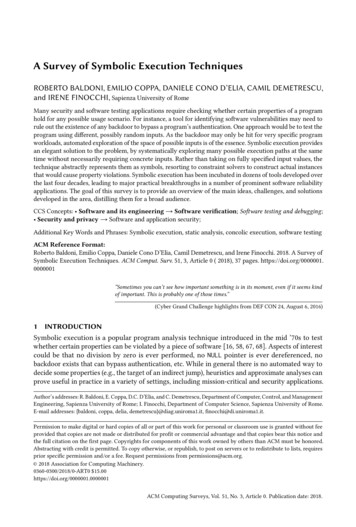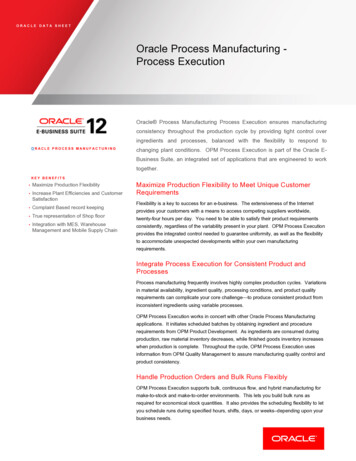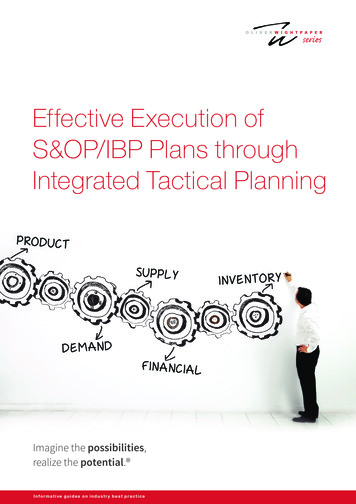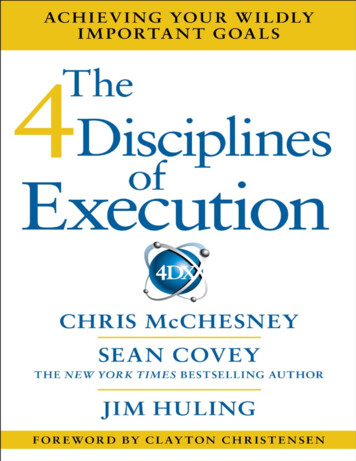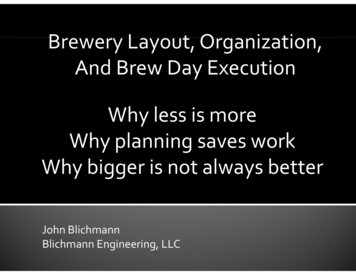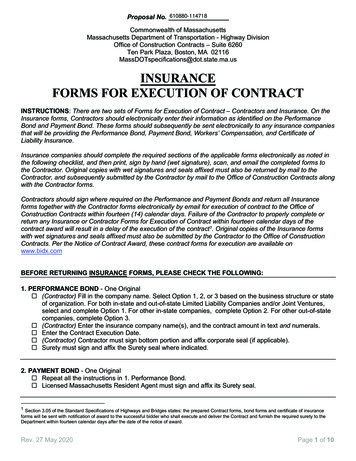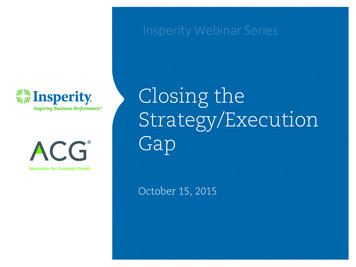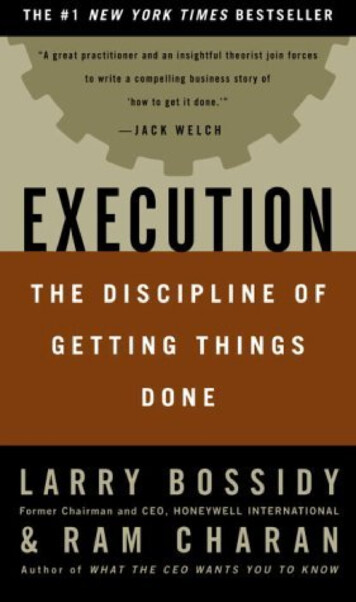
Transcription
ex-e-cu-tion (ek si kyoo shun), n. 1. Themissing link. 2. The main reason companiesfall short of their promises. 3. The gapbetween what a company’s leaders want toachieve and the ability of their organizationsto deliver it. 4. Not simply tactics, but a sys tem of getting things done through question ing, analysis, and follow-through. A disciplinefor meshing strategy with reality, aligning peo ple with goals, and achieving the resultspromised. 5. A central part of a company’sstrategy and its goals and the major job of anyleader in business. 6. A discipline requiring acomprehensive understanding of a business,its people, and its environment. 7. The way tolink the three core processes of any business—the people process, the strategy, and the oper ating plan—together to get things done on time.8. A method for success discovered andrevealed in 2002 by Larry Bossidy and RamCharan in Execution: The Discipline ofGetting Things Done.
Pr evious books by Ram CharanWhat the CEO Wants You to KnowBoards That WorkEvery Business Is a Growth Business (coauthor)The Leadership Pipeline (coauthor)E-Board Strategies (coauthor)Strategic Management: A Casebook in Policy andPlanning (coauthor)
EXECUTIONTHE DISCIPLINE OF GETTING THINGS DONEL ARRY BOSSIDY ANDRAM CHARANwith Charles Burck
Copyright 2002 by Larry Bossidy and Ram CharanAll rights reserved. No part of this book may be reproduced or trans mitted in any form or by any means, electronic or mechanical,including photocopying, recording, or by any information storageand retrieval system, without permission in writing from the pub lisher.Published by Crown Business, New York, New York.Member of the Crown Publishing Group, a division of RandomHouse, Inc.www.randomhouse.comCROWN BUSINESS is a trademark and the Rising Sun colophon isa registered trademark of Random House, Inc.Library of Congress Cataloging-in-Publication DataBossidy, Larry.Execution : the discipline of getting things done / Larry Bossidy& Ram Charan ; with Charles Burck.—1st ed.1. Management. 2. Performance. 3. Achievement motivation.I. Charan, Ram. II. Burck, Charles. III. Title.HD31 .B626 2002658—dc21ISBN 1-400-04617-3v1.02002018743
To the hundreds of people who touched ourbusiness lives and influenced the thoughts artic ulated in this book. A special recognition toJack Welch, who in our time was the predomi nant practitioner of “getting things done.”Larry BossidyRam Charan
CONTENTS1IntroductionPART I: WHY EXECUTION IS NEEDED1:The Gap Nobody Knows132:The Execution Difference35PART II: THE BUILDING BLOCKS OF EXECUTION3:4:5:Building Block One: The Leader’s SevenEssential Behaviors57Building Block Two: Creating theFramework for Cultural Change85Building Block Three: The Job No LeaderShould Delegate—Having the Right Peoplein the Right Place109
CONTENTSPART III: THE THREE CORE PROCESSESOF EXECUTION6:The People Process: Making the Link withStrategy and Operations141The Strategy Process: Making the Link withPeople and Operations1788:How to Conduct a Strategy Review2079:The Operations Process: Making the Linkwith Strategy and People226Conclusion: Letter to a New Leader265Index2717:viii
EXECUTIONThis book has been optimized for viewing at a monitorsetting of 1024 768 pixels.
INTRODUCTIONLARRY*: My job at Honeywell International these days isto restore the discipline of execution to a company that hadlost it. Many people regard execution as detail work that’sbeneath the dignity of a business leader. That’s wrong. Tothe contrary, it’s a leader’s most important job.This particular journey began in 1991 when, after athirty-four-year career at General Electric, I was namedAlliedSignal’s CEO. I was accustomed to an organizationthat got things done, where people met their commit ments. I took execution for granted. So it was a shockwhen I got to AlliedSignal. Sure, I knew it would be inrough shape, but I wasn’t prepared for the malaise Ifound. The company had lots of hardworking, bright peo-*Throughout this book, coauthors Larry Bossidy and Ram Charan willprovide insights written in the first person. Larry talks primarily from hisexperience as a senior executive at General Electric, AlliedSignal, andHoneywell International. Ram speaks from his wide-ranging thirty-five yearsof experience as an adviser to business leaders and boards of directors aroundthe world.1
INTRODUCTIONple, but they weren’t effective, and they didn’t place apremium on getting things done.Viewed on the surface, AlliedSignal had the same basiccore processes as GE or most other companies: it had onefor people, one for strategy, and one for budgeting oroperations. But unlike the processes at GE, those atAlliedSignal weren’t yielding results. When you managethese processes in depth, you get robust outputs. You getanswers to critical questions: Are our products positionedoptimally in the marketplace? Can we identify how we’regoing to turn the plan into specific results for growth andproductivity? Are we staffed with the right kinds of peo ple to execute the plan? If not, what are we going to doabout it? How do we make sure the operating plan hassufficiently specific programs to deliver the outcomes towhich we’ve committed?At AlliedSignal, we weren’t even asking those ques tions. The processes were empty rituals, almost abstrac tions. People did a lot of work on them, but very little ofit was useful. The business unit strategic plans, for exam ple, were six-inch-thick books full of data about products,but the data had little to do with strategy. The operatingplan was strictly a numbers exercise, with little attentionpaid to action plans for growth, markets, productivity, orquality. People were holding the same jobs too long, andmany plants were run by accountants instead of produc tion people.AlliedSignal had no productivity culture. It measuredcost-per-man-hour in its plants but had no companywidemeasure for real productivity growth. It lacked learning oreducation. Individual businesses were allowed to havetheir own identities instead of being joined under theAlliedSignal name. I was told, “We’ve got a chemical cul ture, an automotive culture, and an aerospace culture, and2
INTRODUCTIONthey don’t like each other.” “We’ve got one stock thatinvestors buy,” I replied. “We need one brand.”Most fundamentally, the three core processes were disconnected from the everyday realities of the business, andfrom each other. Leading these processes is the real job ofrunning a business. The leader has to believe in them andbe actively involved in them. But the former CEO hadn’tbeen deeply involved with them. He saw his job as buy ing and selling businesses.Our new team conducted the processes with rigor andintensity. By the time I retired —after the merger withHoneywell in 1999—we had tripled our operating margins to almost 15 percent, raised our return on equityfrom just over 10 percent to 28 percent, and delivered analmost ninefold return for shareholders. How did we doit? We created a discipline of execution.Putting an execution environment in place is hard, butlosing it is easy. Less than two years later, the picture hadchanged again. The company didn’t deliver the resultsinvestors expected, and the stock price was down. Afterthe proposed merger with GE fell through, Honeywell’sboard asked me to spend a year getting the company backon track.Certainly the distraction and uncertainty of the mergereffort had taken a toll. Good people had left or were leav ing. But the discipline of execution had unraveled. Theintensity of the core processes had waned. Honeywellwasn’t getting things done.Before I left the company, for example, we had devel oped a turbogenerator product that I thought was a verypromising entry into the market for standby power. Itwould be perfect for small businesses such as 7-Elevenstores. On returning, I found the product had been builtincorrectly—it was too small for the market and would3
INTRODUCTIONrun only on natural gas, when we needed to offer both oiland gas alternatives. Sales were pathetic. People expectedthat I’d find some way to salvage the product—after all,I had been the instigator. But when I looked at the situa tion, I saw it was too far gone. We’d be better off spend ing the money on something else. So we closed it down.When a company executes well, its people are not vic tims of mistakes like this. If Honeywell had had an exe cution culture, either the turbogenerator would have beenbuilt correctly from the outset, or it would have beenfixed soon enough to be successful.And when a company executes well, its people are notbrought to their knees by changes in the business envi ronment. After the tragic events of September 11, wehad to tear up our aerospace operating plan for 2001.But we put together a new one in ten days. We identifiedas best we could the shortfalls of revenue, and wedecided what we’d have to do to offset them with costcuts. We also put a team in place to coordinate and rampup all of our security products, and we reenergized ourdefense marketing folks.RAM: There aren’t many companies where leaderswould produce a new operating plan for a major part ofthe company in ten days. More often there’d be a lot oftalk and off-site conferences but no action. That’s onedistinction between companies that execute and thosethat don’t.Too many leaders fool themselves into thinking theircompanies are well run. They’re like the parents inGarrison Keillor’s fictional Lake Wobegon, all of whomthink their children are above average. Then the top performers at Lake Wobegon High School arrive at theUniversity of Minnesota or Colgate or Princeton and find4
INTRODUCTIONout they’re average or even below average. Similarly,when corporate leaders start understanding how the GEsand Emerson Electrics of this world are run—howsuperbly they get things done—they discover how far theyhave to go before they become world class in execution.In the past businesses got away with poor execution bypleading for patience. “The business environment is toughright now” is one typical excuse; or “Our strategy willtake time to produce results.” But the business environ ment is always tough, and success is no longer measuredover years. A company can win or lose serious marketshare before even it realizes what has hit it. Johnson &Johnson, for example, pioneered the stent, a mesh tubethat is inserted surgically and is used to support cloggedarteries. In 1997 and 1998 it lost 95 percent of the 700million market it had created to competitors who offeredbetter technology and lower pricing. Only recently has itbegun a comeback, introducing new versions with clearperformance advantages.Execution is now tested on a quarterly basis—and notjust by the numbers. Securities analysts look to see whethera company is showing progress toward meeting its quar terly goals. If they think it isn’t, their downgrades can wipeout billions of dollars in market capitalization.Most often today the difference between a companyand its competitor is the ability to execute. If your com petitors are executing better than you are, they’re beatingyou in the here and now, and the financial markets won’twait to see if your elaborate strategy plays out. So leaderswho can’t execute don’t get free runs anymore. Executionis the great unaddressed issue in the business world today.Its absence is the single biggest obstacle to success and thecause of most of the disappointments that are mistakenlyattributed to other causes.5
INTRODUCTIONAs an adviser to senior leaders of companies large andsmall, I often work with a client for ten or more consecu tive years. I have the opportunity to observe corporatedynamics over time and to participate directly in them. Ifirst began to identify the problem of execution more thanthree decades ago, as I observed that strategic plans oftendid not work out in practice. As I facilitated meetings atthe CEO and division levels, I watched and studied, and Isaw that leaders placed too much emphasis on what somecall high-level strategy, on intellectualizing and philoso phizing, and not enough on implementation. Peoplewould agree on a project or initiative, and then nothingwould come of it. My own nature is to follow through, sowhen this happened, I’d pick up the phone, call the person in charge, and ask, “What happened?” In time I sawa pattern and realized that execution was a major issue.Here is the fundamental problem: people think of exe cution as the tactical side of business, something leadersdelegate while they focus on the perceived “bigger” issues.This idea is completely wrong. Execution is not just tactics—it is a discipline and a system. It has to be built intoa company’s strategy, its goals, and its culture. And theleader of the organization must be deeply engaged in it.He cannot delegate its substance. Many business leadersspend vast amounts of time learning and promulgatingthe latest management techniques. But their failure tounderstand and practice execution negates the value ofalmost all they learn and preach. Such leaders are build ing houses without foundations. Execution is not only the biggest issue facing businesstoday; it is something nobody has explained satisfactorily.6
INTRODUCTIONOther disciplines have no shortage of accumulatedknowledge and literature. Strategy? So much thinking hasgone into strategy that it’s no longer an intellectual chal lenge. You can rent any strategy you want from a con sulting firm. Leadership development? The literature on itis endless. Innovation? Ditto. Nor is there any shortage oftools and techniques that can help leaders get thingsdone—approaches to organization structure and incen tive systems, business process design, methodologies forpromoting people, guides to culture change.We talk to many leaders who fall victim to the gapbetween promises they’ve made and results their organi zations delivered. They frequently tell us they have aproblem with accountability—people aren’t doing thethings they’re supposed to do to implement a plan. Theydesperately want to make changes of some kind, but whatdo they need to change? They don’t know.So we see a great need for this book. Execution is notjust something that does or doesn’t get done. Execution isa specific set of behaviors and techniques that companiesneed to master in order to have competitive advantage. Itis a discipline of its own. In big companies and small ones,it is the critical discipline for success now.Execution will help you, as a business leader, to choosea more robust strategy. In fact, you can’t craft a worthwhile strategy if you don’t at the same time make sureyour organization has or can get what’s required to exe cute it, including the right resources and the right people.Leaders in an execution culture design strategies that aremore road maps than rigid paths enshrined in fat planningbooks. That way they can respond quickly when theunexpected happens. Their strategies are designed to beexecuted.Execution paces everything. It enables you to see what’s7
INTRODUCTIONgoing on in your industry. It’s the best means for changeand transition—better than culture, better than philoso phy. Execution-oriented companies change faster thanothers because they’re closer to the situation.If your business has to survive difficult times, if it hasto make an important shift in response to change—andthese days just about every business does—it’s far, farmore likely to succeed if it’s executing well.Leading for execution is not rocket science. It’s verystraightforward stuff. The main requirement is that youas a leader have to be deeply and passionately engaged inyour organization and honest about its realities with oth ers and yourself.This is true whether you’re running a whole companyor your first profit center. Any business leader, at anycompany or any level, needs to master the discipline ofexecution. This is the way you establish credibility as aleader. By the time you’ve finished this book, you’ll understand how to do it. Your know-how of the discipline ofexecution will be a competitive advantage. If you thenproceed to put it into action in your business, we knowyou’ll generate better results. In part 1, chapters 1 and 2, we explain the discipline ofexecution, why it is so important today, and how it can dif ferentiate you from your competitors. Part 2, chapters 3 to5, shows that execution doesn’t just happen. Fundamentalbuilding blocks need to be in place, and we identify anddescribe the most important: the leader’s personal priorities, the social software of culture change, and the leader’smost important job—selecting and appraising people.8
INTRODUCTIONPart 3 is the how-to section of the book. Chapters 6 to9 discuss the three core processes of people, strategy, andoperations. We show what makes them effective, and howthe practice of each process is linked to and integratedwith the other two.Chapter 6 covers the people process, which is the mostimportant of the three. Done well, it results in a leadership gene pool that can conceive and shape executablestrategies and convert them into operating plans and spe cific points of accountability.Chapters 7 and 8 cover the strategy process. We showhow effective strategic planning can bring you from con ceptual thinking at 50,000 feet down to reality: thisprocess develops a strategy building block by buildingblock, testing its executability. It also links back to thepeople process. If the strategy proposed and its backuplogic are clearly in sync with the realities of the marketplace, the economy, and the competition, then the peopleprocess has worked. The right people are in the right jobs.The problem with many so-called strategies is that they’retoo abstract and shallow, or else they’re really operationsplans, not strategies. The leadership and its capabilitiesmay be mismatched: for example, a leader may have greatskills in a business function like marketing or finance butmay not be a strategist.In chapter 9 we show that no strategy delivers resultsunless it’s converted into specific actions. The operationsprocess shows how to build, block by block, an operatingplan that will deliver the strategy. Both the strategy andoperations plans link with the people process to test thematch between organizational capabilities and what isrequired to execute the operating plan.9
PART IWHY EXECUTIONIS NEEDED
CHAPTER 1The Gap Nobody KnowsThe CEO was sitting in his office late one evening, look ing tired and drained. He was trying to explain to a visi tor why his great strategic initiative had failed, but hecouldn’t figure out what had gone wrong.“I’m so frustrated,” he said. “I got the group togethera year ago, people from all the divisions. We had twooff-site meetings, did benchmarking, got the metrics.McKinsey helped us. Everybody agreed with the plan. Itwas a good one, and the market was good.“This was the brightest team in the industry, no ques tion about it. I assigned stretch goals. I empoweredthem—gave them the freedom to do what they needed todo. Everybody knew what had to be done. Our incentivesystem is clear, so they knew what the rewards and penalties would be. We worked together with high energy. Howcould we fail?“Yet the year has come to an end, and we missed thegoals. They let me down; they didn’t deliver the results. Ihave lowered earnings estimates four times in the past13
EXECUTIONnine months. We’ve lost our credibility with the Street. Ihave probably lost my credibility with the board. I don’tknow what to do, and I don’t know where the bottom is.Frankly, I think the board may fire me.”Several weeks later the board did indeed fire him.This story—it’s a true one—is the archetypal story ofthe gap that nobody knows. It’s symptomatic of thebiggest problem facing corporations today. We hear lotsof similar stories when we talk to business leaders.They’re played out almost daily in the press, when itreports on companies that should be succeeding butaren’t: Aetna, A T&T, British Airways, Campbell Soup,Compaq, Gillette, Hewlett-Packard, Kodak, LucentTechnologies, Motorola, Xerox, and many others.These are good companies. They have smart CEOs andtalented people, they have inspiring visions, and theybring in the best consultants. Yet they, and many othercompanies as well, regularly fail to produce promisedresults. Then when they announce the shortfall, investorsdump their stocks and enormous market value is obliter ated. Managers and employees are demoralized. Andincreasingly, boards are forced to dump the CEOs.The leaders of all the companies listed above werehighly regarded when they were appointed—they seemedto have all of the right qualifications. But they all losttheir jobs because they didn’t deliver what they saidthey would. In the year 2000 alone, forty CEOs of thetop two hundred companies on Fortune’s 500 list wereremoved—not retired but fired or made to resign. When20 percent of the most powerful business leaders inAmerica lose their jobs, something is clearly wrong. Thistrend continued in 2001 and will clearly be in evidencein 2002.In such cases it’s not just the CEO who suffers—so do14
THE GAP NOBODY KNOWSthe employees, alliance partners, shareholders, and evencustomers. And it’s not just the CEO whose shortcomingscreate the problem, though of course he or she is ulti mately responsible.What is the problem? Is it a rough business environ ment? Yes. Whether the economy is strong or weak, com petition is fiercer than ever. Change comes faster thanever. Investors —who were passive when today’ s seniorleaders started their careers—have turned unforgiving.But this factor by itself doesn’t explain the near-epidemicof shortfalls and failures. Despite this, there are compa nies that deliver on their commitments year in and yearout—companies such as GE, Wal-Mart, Emerson,Southwest Airlines, and Colgate-Palmolive.When companies fail to deliver on their promises, themost frequent explanation is that the CEO’s strategy waswrong. But the strategy by itself is not often the cause.Strategies most often fail because they aren’t executed well.Things that are supposed to happen don’t happen. Eitherthe organizations aren’t capable of making them happen,or the leaders of the business misjudge the challenges theircompanies face in the business environment, or both.Former Compaq CEO Eckhard Pfeiffer had an ambi tious strategy, and he almost pulled it off. Before any ofhis competitors, he saw that the so-called Wintel architecture—the combination of the Windows operating sys tem and Intel’s constant innovation—would serve foreverything from a palm-held to a linked network ofservers capable of competing with mainframes.Mirroring IBM, Pfeiffer broadened his base to serve allthe computing needs of enterprise customers. He boughtTandem, the high-speed, failsafe mainframe manufac turer, and Digital Equipment Company (DEC) to giveCompaq serious entry into the services segment. Pfeiffer15
EXECUTIONmoved at breakneck speed on his bold strategic vision,transforming Compaq from a failing niche builder ofhigh-priced office PCs to the second-biggest computercompany (after IBM) in just six years. By 1998 it waspoised to dominate the industry.But the strategy looks like a pipe dream today.Integrating the acquisitions and delivering on thepromises required better execution than Compaq wasable to achieve. More fundamentally, neither Pfeiffer norhis successor, Michael Capellas, pursued the kind of exe cution necessary to make money as PCs became more andmore of a commodity business.Michael Dell understood that kind of execution. Hisdirect-sales and build-to-order approach was not just amarketing tactic to bypass retailers; it was the core of hisbusiness strategy. Execution is the reason Dell passedCompaq in market value years ago, despite Compaq’svastly greater size and scope, and it’s the reason Dellpassed Compaq in 2001 as the world’s biggest maker ofPCs. As of November 2001, Dell was shooting to doubleits market share, from approximately 20 to 40 percent.Any company that sells direct has certain advantages:control over pricing, no retail markups, and a sales forcededicated to its own products. But that wasn’t Dell’s secret.After all, Gateway sells direct too, but lately it has fared nobetter than Dell’s other rivals. Dell’s insight was that build ing to order, executing superbly, and keeping a sharp eyeon costs would give him an unbeatable advantage.In conventional batch production manufacturing, abusiness sets its production volume based on the demandthat is forecast for the coming months. If it has outsourced component manufacturing and just does theassembling, like a computer maker, it tells the componentsuppliers what volumes to expect and negotiates the16
THE GAP NOBODY KNOWSprices. If sales fall short of projections, everybody getsstuck with unsold inventory. If sales are higher, theyscramble inefficiently to meet demand.Building to order, by contrast, means producing a unitafter the customer’s order is transmitted to the factory.Component suppliers, who also build to order, get theinformation when Dell’s customers place their orders.They deliver the parts to Dell, which immediately placesthem into production, and shippers cart away themachines within hours after they’re boxed. The systemsqueezes time out of the entire cycle from order to delivery—Dell can deliver a computer within a week or less ofthe time an order is placed. This system minimizes inven tories at both ends of the pipeline, incoming and outgoing.It also allows Dell customers to get the latest technologi cal improvements more often than rivals’ customers.Build-to-order improves inventory turnover, whichincreases asset velocity, one of the most underappreciatedcomponents of making money. Velocity is the ratio ofsales dollars to net assets deployed in the business,which in the most common definition includes plant andequipment, inventories, and accounts receivable minusaccounts payable. Higher velocity improves productivityand reduces working capital. It also improves cash flow,the life blood of any business, and can help improve margins as well as revenue and market share.Inventory turns are especially important for makers ofPCs, since inventories account for the largest portion oftheir net assets. When sales fall below forecast, companieswith traditional batch manufacturing, like Compaq, arestuck with unsold inventory. What’s more, computer com ponents such as microprocessors are particularly prone toobsolescence because performance advances so rapidly,often accompanied by falling prices. When these PC mak17
EXECUTIONers have to write off the excess or obsolete inventory, theirprofit margins can shrink to the vanishing point.Dell turns its inventory over eighty times a year, com pared with about ten to twenty times for its rivals, and itsworking capital is negative. As a result, it generates anenormous amount of cash. In the fourth quarter of fiscal2002, with revenues of 8.1 billion and an operating margin of 7.4 percent, Dell had cash flow of 1 billion fromoperations. Its return on invested capital for fiscal 2001was 355 percent—an incredible rate for a company withits sales volume. Its high velocity also allows it to give cus tomers the latest technological improvements ahead ofother makers, and to take advantage of falling componentcosts—either to improve margins or to cut prices.These are the reasons Dell’s strategy became deadly forits competitors once PC growth slowed. Dell capitalizedon their misery and cut prices in a bid for market share,increasing the distance between it and the rest of theindustry. Because of its high velocity , Dell could showhigh return on capital and positive cash flow, even withmargins depressed. Its competition couldn’t.The system works only because Dell executes meticu lously at every stage. The electronic linkages among suppliers and manufacturing create a seamless extendedenterprise. A manufacturing executive we know whoworked at Dell for a time calls its system “the best man ufacturing operation I’ve ever seen.”As this book goes to press, the merger betweenCompaq and Hewlett-Packard, proposed in mid-2001, isstill up in the air. No matter: Alone or in combination,nothing they do will make them competitive with Dellunless they come up with an equal or better build-toorder production model.The chronic underperformers we’ve mentioned so far18
THE GAP NOBODY KNOWShave lots of company. Countless others are less than theycould be because of poor execution. The gap betweenpromises and results is widespread and clear. The gapnobody knows is the gap between what a company’s lead ers want to achieve and the ability of their organizationto achieve it.Everybody talks about change. In recent years, a smallindustry of changemeisters has preached revolution, rein vention, quantum change, breakthrough thinking, auda cious goals, learning organizations, and the like. We’renot necessarily debunking this stuff. But unless you translate big thoughts into concrete steps for action, they’repointless. Without execution, the breakthrough thinkingbreaks down, learning adds no value, people don’tmeet their stretch goals, and the revolution stops deadin its tracks. What you get is change for the worse,because failure drains the energy from your organization.Repeated failure destroys it.These days we’re hearing a more practical phrase on thelips of business leaders. They’re talking about taking theirorganizations to the “next level,” which brings therhetoric down to earth. GE CEO Jeff Immelt, for exam ple, is asking his people how they can use technology todifferentiate their way to the next level and command bet ter prices, margins, and revenue growth.This is an execution approach to change. It’s realitybased—people can envision and discuss specific thingsthey need to do. It recognizes that meaningful changecomes only with execution.No company can deliver on its commitments
tem of getting things done through question ing, analysis, and follow-through. A discipline for meshing strategy with reality, aligning peo ple with goals, and achieving the results promised. 5. A central part of a company’s strategy and its goals and the major j

